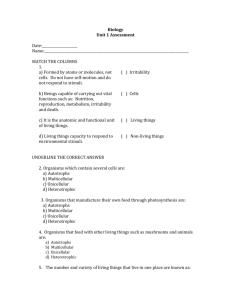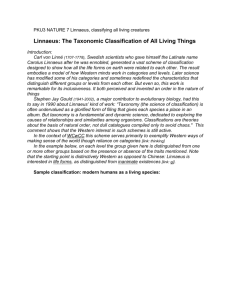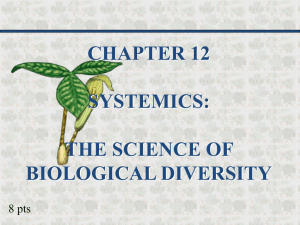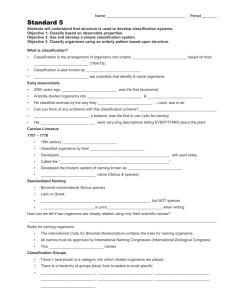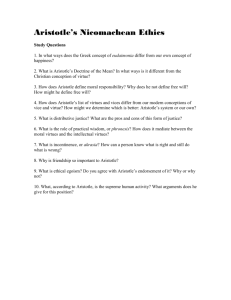History Of Classification
advertisement
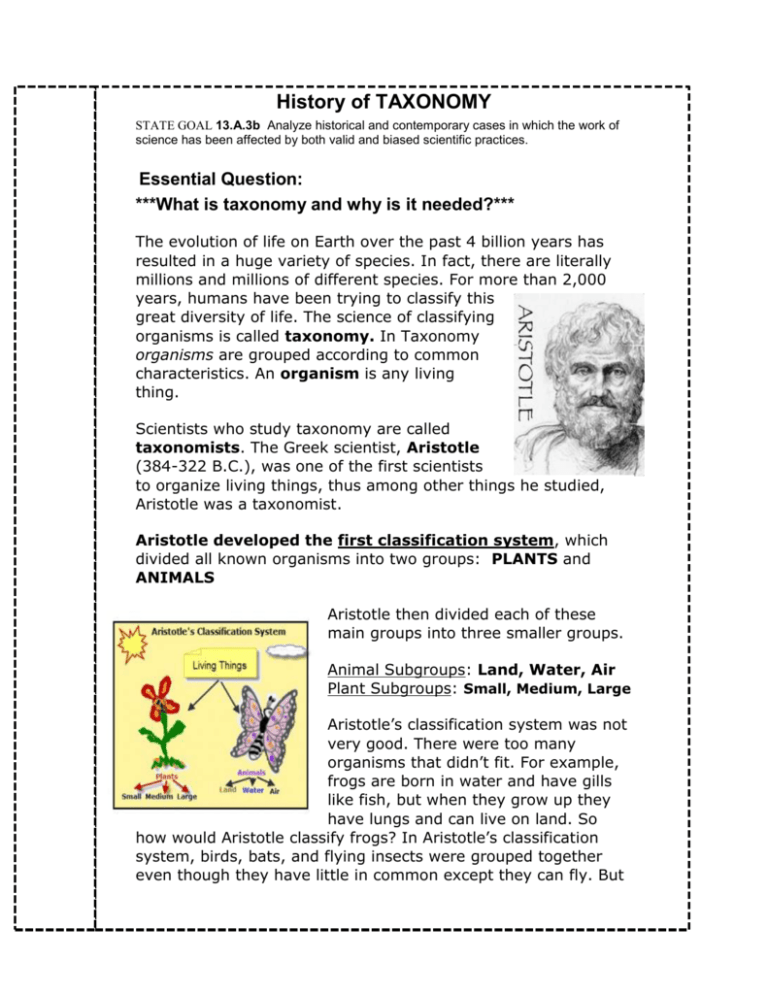
History of TAXONOMY STATE GOAL 13.A.3b Analyze historical and contemporary cases in which the work of science has been affected by both valid and biased scientific practices. Essential Question: ***What is taxonomy and why is it needed?*** The evolution of life on Earth over the past 4 billion years has resulted in a huge variety of species. In fact, there are literally millions and millions of different species. For more than 2,000 years, humans have been trying to classify this great diversity of life. The science of classifying organisms is called taxonomy. In Taxonomy organisms are grouped according to common characteristics. An organism is any living thing. Scientists who study taxonomy are called taxonomists. The Greek scientist, Aristotle (384-322 B.C.), was one of the first scientists to organize living things, thus among other things he studied, Aristotle was a taxonomist. Aristotle developed the first classification system, which divided all known organisms into two groups: PLANTS and ANIMALS Aristotle then divided each of these main groups into three smaller groups. Animal Subgroups: Land, Water, Air Plant Subgroups: Small, Medium, Large Aristotle’s classification system was not very good. There were too many organisms that didn’t fit. For example, frogs are born in water and have gills like fish, but when they grow up they have lungs and can live on land. So how would Aristotle classify frogs? In Aristotle’s classification system, birds, bats, and flying insects were grouped together even though they have little in common except they can fly. But the penguin is a bird that cannot fly. So Aristotle would not have classified them as birds. Even with the many problems of Aristotle’s limited classification system, it was used for nearly 2000 years. Then in the 1750’s it was replaced by the Swedish biologist, Carolus Linnaeus (1707-1778). Linnaeus, like Aristotle, classified organisms according to their traits. The classification systems of both Aristotle and Linnaeus started with the same two groups: Plants and Animals. Linnaeus called these groups kingdoms. But, unlike Aristotle, Linnaeus divided the kingdoms into 4 more levels: class, order, genus, and species. Kingdom was divided into smaller groups called classes. Each class was split into orders. Each order was divided into genus and each genus into many species. Organisms were placed in these levels based on traits, including similarities of body parts, physical form such as size, shape, and methods of getting food. In addition to expanding the classification system, Linnaeus established a simple way of naming each species. This is called binomial nomenclature and is a naming system with two parts. The first part of the species name identifies the genus; the second part identifies the species. For example, humans belong to the genus Homo and to the species sapien. Thus, the two-part species name for humans is Homo sapien. The genus name is capitalized and each name is written in italics. For expanding the classification system and for creating a naming system, Linnaeus is known as the father of taxonomy. Today, Linnaeus basic structure is still used; however, some other divisions have been added. (Pg. 43) Today the taxonomy order used from largest grouping to smallest grouping is as follows: LEVELS OF CLASSIFICATION: LARGEST TO SMALLEST GROUP Domain Example using Humans: DOMAIN: Eukaryota * Kingdom KINGDOM: Animalia Phylum Class PHYLUM: Chordata EXAMPLE CLASS: Mammalia Order ORDER: Primata Family FAMILY: Hominidae Genus GENUS: Homo Species SPECIES: Homo Sapien *Eukaryotes have a Nucleus in their cells! Here is a Mnemonic Device to help you in remembering taxonomy order from largest to smallest group: Dumb King Phillip Could Only Find Green Socks! Domain-Kingdom-Phylum-Class-Order-Genus-Species Name ___________________ Period # _______________ History of Taxonomy Homework Date _________________ Look back in the reading and write definitions for: 1. Taxonomy - 2. Organism – 3. Which scientist developed the FIRST system of organization in which organisms were divided into 2 main groups? ______ 4. These 2 main groups of organisms were __________ & ________________ 5. In the space below, complete the diagram to show the first system of classification: Animal Subgroup _________ Subgroup 1. Land Animals 1. _______ 2. ________ Animals 2. Medium 3. _______ Animals 3. _________ 6. Explain why the system of classification shown above is not very good and give an example: 7. In the 1750’s this classification system was replaced by a system developed by Carolus Linneaus. His system also divided organisms into Plants & Animals. How did Linneaus’ classification system DIFFER from Aristotle’s? 8. Linnaeus developed a 2 part naming system for each species. This system is called _____________ _______________________. 9. For example; humans are Homo sapiens. Using this system, humans belong to the GENUS ___________ & the SPECIES ____________ To answer the next question requires you to do some critical thinking. The answer is NOT in the reading!! 10. HIGH LEVEL OF REASONING = EVALUATING You are a taxonomist! A fellow scientist approaches you and says that classifying organisms into groups is a waste of scientific time. You disagree! What 2 arguments would you use to defend the practice of classification in Science? (Your answer may take the form of: a bulleted list, a concept web, thought bubbles or written paragraph.


